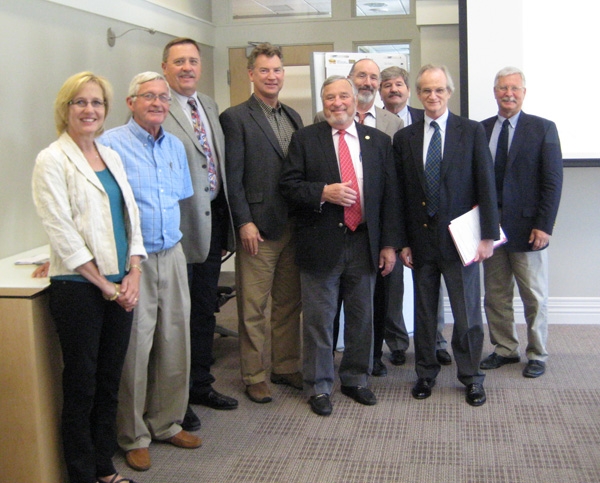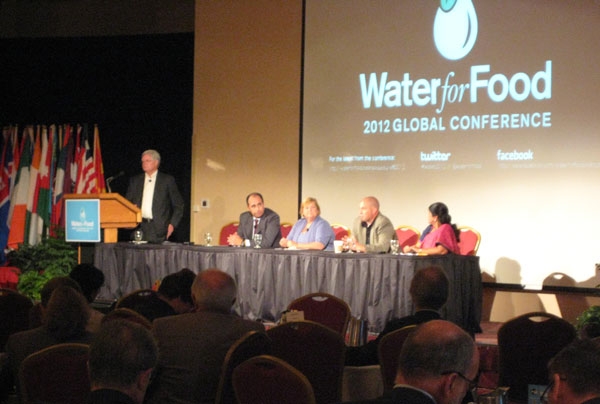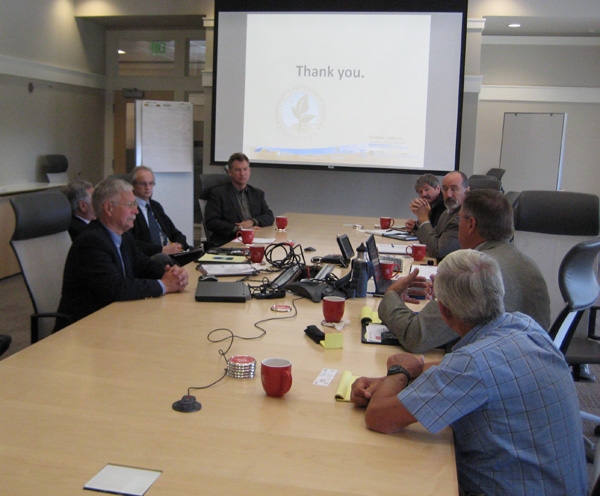Conservation agriculture news
California can learn from Nebraska's irrigation technology success
Conservation Agriculture Systems Innovation (CASI) has a vision for California – a vision in which farmers make more money while using less water and protecting the environment. However, the organization has been frustrated that the progress in getting these ag systems adopted by farmers has been rather slow. A member of the CASI executive board and a project director with the California Association of Resource Conservation Districts, Ron Harben, brought up the point with a panel of industry experts at the Water for Food Conference in Lincoln, Neb., May 31.
Water for Food Conference speakers address issues of importance to Californians
The confluence of global climate change and population growth is brewing a “perfect storm” that threatens the availability of sufficient fresh water to grow food to feed the world by 2025, warned Colin Chartres, the director general of the International Water Management Institute in Sri Lanka.
Chartres spoke at the Water for Food Global Conference in Lincoln, Neb., May 30. More than 500 attendees from 28 countries on 6 continents have convened in Lincoln to address the challenges of food security in relation to water supplies. The conference continues through Saturday.
“We will have to feed 2 billion more people with less water than we now have in an era of climate change,” Chartres noted in his presentation. “How we deal with water scarcity over the next 10 to 20 years will have a fundamental impact on food security, poverty reduction and the environment in years to come.”
He offered four solutions for skirting this ”perfect storm”:
Healthier diet: Currently, producers grow food to provide about 2,800 to 3,000 calories per person per day, including 224 grams of meat. If people instead were to eat a healthier diet with much less meat (an average of about 90 grams), the world would realize water savings of 1,350 cubic kilometers. “By anybody’s standard, that’s a lot of water,” Chartes said.
Reduce waste. Currently, a tremendous amount of food is thrown away at the point of production and the point of consumption, representing a significant waste of water used in the food production.
Encourage trade. Grow water-hungry crops in water-rich areas. This concept is already driving geo-politics, Chartes said. Water-scarce countries are thinking about where to get their food in the future.
Increase productivity. Produce more crop per drop in irrigated and rain-fed agricultural systems.
The efforts of the Conservation Agriculture Systems Innovation (CASI) workgroup can play a role in preventing the “perfect storm” in California, the United State’s No. 1 ag producer. CASI’s research and education programs will allow farmers to grow more food with less water by helping them convert flood irrigation systems, currently used on 57 percent of the state’s cropland, to more water efficient irrigation systems, such as mechanized overhead and subsurface drip systems. Combining the efficient irrigation with conservation tillage saves still more water. CASI research has shown that systems with improved application efficiency can cut irrigation water requirements by 10 to 30 percent.
During the producer’s panel discussion at the Water for Food Conference, two American farmers – one from Nebraska, the other from Iowa – described their use of conservation tillage techniques and mechanized irrigation to increase farm efficiency.
Farmer Brandon Hunnicutt works 2,600 acres with his father and brother on a Nebraska farm that has been in the family for 100 years. He said they have made tremendous strides in reducing inputs – tillage, water, fertilizer and pesticides – using mechanized irrigation equipment, conservation tillage and Watermark soil moisture sensors. The sensors send information to a cellphone or tablet computer for real-time remote monitoring of the moisture being held in the soil.
“My uncle farms down the road. It was fun to watch them irrigate, when we held off,” Hunnicutt said. “We were saving water, saving electricity and wear and tear on the equipment. I was excited to see just how far we were able to go with less fertilizer and less water while maintaining yield.”
Farmer April Hemmes of Iowa said she believes precision farming techniques will be particularly important in the future. For example, on her farm, they have mapped all the soil and apply fertilizer at a variable rate.
“Those of us farming in the Missouri and Mississippi valleys have a target on us,” Hemmes said. “We are being blamed for the dead zone in the Gulf. (A region of oxygen-depleted water off the Louisiana and Texas coasts that is harmful to sea life.) We have to be far more precise with nutrients and manure management. I think in the future, that will play a lot in how we farm.”
CASI chair Jeff Mitchell, UC Cooperative Extension specialist in the Department of Plant Sciences at UC Davis, said the Water for Food Conference has provided an inspiring large-scale perspective on emerging global issues that people from around the world are working on.
“The insights and the projections for how and if water resources are going to be sufficiently managed to address the inevitable population changes are enormously important,” Mitchell said. “They will compel us to work even more assiduously on improved systems, on technology development and adoption of improved management practices.”
He complimented the University of Nebraska, Lincoln, sponsor of the Water for Food Conference, for the coordination of their initiatives to address global water issues and the success they have had in establishing the Water for Food Institute.
“It's striking to me optimism the University of Nebraska has,” Mitchell said. “The optimism is motivating to me personally.”
CASI seeks collaborative partnership with the Water for Food Institute
UC's Conservation Agriculture Systems Innovation (CASI) proposed the idea of creating a formal partnership with the University of Nebraska, Lincoln, Water for Food Institute at a meeting May 29 with Water for Food executive director Roberto Lenton and senior research scientist Marc Andreini. The proposal will be taken under consideration over the next 12 months as Water for Food and CASI continue to develop programs that enhance agricultural productivity while minimizing water use, ag production cost and environmental impacts.
Seven CASI representatives traveled to Nebraska for the annual Water for Food Conference, May 30 to June 2. The group arrived early to reach out to Water for Food leaders.
CASI chair Jeff Mitchell, UC Cooperative Extension specialist in the UC Davis Department of Plant Sciences, said a partnership between Water for Food and CASI would be designed to foster:
- Information exchange activities
- Focused joint research and demonstration activities on improving the efficiency of water use in agriculture through the development of new technologies for diverse crops
- Student training exchange programs
- International conservation agriculture and precision irrigation training programs
- An opportunity to achieve greater impact to accelerate the adoption of improved systems
Water for Food is a research, education and policy analysis institute committed to helping the world efficiently use its limited freshwater resources, with particular focus on ensuring the food supply for current and future generations. CASI is seeking to launch an effort that combines research, demonstrations and outreach to increase adoption of conservation agriculture systems in California, systems that ensure maximum water use efficiency.
California farmers, like growers in many important agricultural areas around the world, have developed successful food production systems but aren't always interested in investing in the latest technology. The lost food production potential is enormous.
"If all the known technologies were adopted throughout the world, we likely wouldn't be seeing the social problems and hunger problems we see today," said Ron Harben, a member of the CASI executive board and director of the California Association of Resource Conservation Districts. "California can be an implementation laboratory for global efforts. Once we know how to successfully effect change, this process can be duplicated in other countries."
A mainstay in conservation agricultural systems is the use of overhead mechanized irrigation, such as center pivot. Nebraska has been a leader in implementation of these systems and is the home of four major mechanized irrigation systems manufacturers. Nebraska boasts 85,000 center pivot irrigation systems; only several hundred are being operated in California.
A growing body of research has shown significant economic and environmental benefits of mechanized irrigation, especially when combined with conservation tillage practices.
CASI executive board member Dan Schuler, sales manager for Senniger Irrigation Company, suggested one reason California farmers have been slow to adopt overhead irrigation is the proximity of drip and micro sprinkler irrigation dealers on the West Coast. Less than enthusiastic interest in conservation tillage may stem from its origin as a solution for erosion problems. The Central Valley of California is flat and receives negligible summer rain. No serious erosion problems are perceived in the Golden State.
Currently, more than half of California farmland is flood irrigated. A significant portion is irrigated with drip systems and micro sprinklers, but these are mainly permanent crops.
Among CASI's goals will be overcoming misperceptions and traditions and finding the right incentives for farmers to implement new technologies. The organization is now actively seeking support for its educational, research and information campaigns.
Water for Food executive director Lenton noted that the issue of encouraging Nebraska farmers to adopt center pivot irrigation systems has been addressed. Now, scientists are looking for ways to finesse even more efficiencies using advanced technologies.
"In California, the issues are more similar to the rest of the world," Lenton said. "There would be a real value in such as partnership."

The California delegation along with Water for Food senior research scientist Marc Andreini and executive director Roberto Lenton.
World experts convene at four Central California conservation agriculture meetings in August
Conservation Agriculture Systems Innovation (CASI) is pleased to sponsor interactive conferences on conservation agriculture and controlled traffic farming at four locations in the Central Valley on Aug. 28, 29 and 30.
Presenters will include:
Jerry Hatfield
Director, USDA ARS National Soil Tilth Lab, Ames, Iowa
Don Reicosky
Retired USDA ARS, Morris, Minnesota
Rolf Derpsch
No-till expert, Paraguay
Clay Mitchell
Farmer, Geneseo, Iowa
John McPhee
Tasmanian Ag Research Institute, Devenport, Tasmania
The meetings will be:
| Aug. 28, 1 - 4 p.m. UC Davis Heidrick Ag Equipment Center 112 Hutchinson UC Davis (530) 752-1898 |
Aug. 29, 1 to 4 p.m.
|
| Aug. 29, 8 to 11 a.m. UC Cooperative Extension - Stanislaus County 3800 Cornucopia Way, Suite A Modesto, CA (209) 525-680 |
Aug. 30, 8 to 11 a.m. |
Conservation agriculture production systems optimize food, fiber and energy production from available resources, increase soil health and productivity by increasing soil organic carbon and build up many additional ecosystem services that cannot be achieved by intensive tillage-based cropping systems.
Controlled traffic farming: Plants grow better in soft soil but wheels work better on roads - the same machinery wheel tracks in cropping fields are maintained year after year. There are a multitude of potential benefits of conservation agriculture and controlled traffic farming. However, these systems are currently very minimally used in California.
The purpose of this series of conferences throughout the Central Valley in August of 2012 will be to bring together world experts on these systems to share information related to the principles of conservation agriculture and controlled traffic farming and to discuss opportunities and benefits these approaches may have for current California systems.
For additional details, view the file attached below:
Aug 2012 CASI field meetings
2012 research update
A brief update here on recent progress and implementation activities related to our 2012 overhead / drip cotton and tomato fields.
2012 Tomatoes
The processing tomato variety ‘N6397’ was transplanted on April 30.
Virtually daily crop growth and development. Sampling is now being done.
Terry Ioerger installed Watermark Irrometer sensors last week and they’re up and running now.
Our 2012 goal is to make sure we optimize water applications in the tomatoes.
I’ve received an idea for UAN32 liquid fertilizer with AGROTAIN PLUS from John Diener and have asked the West Side Research and Extension Center to implement this on Wednesday, May 23. The fertilizer will be shanked in using our coulter-led liquid fertilizer tool bar.
2012 Cotton
The Acala cotton variety, Phytogen 725 RF was planted at 62,000 seeds/acre on May 3. Twelve gallons / acre of 10-34-0 + Avail were applied about 4 inches off the seed line. The entire field was overhead irrigated up the following day and a half.

The UC West Side Research and Extension Center in Five Points the site of conservation agriculture research.



